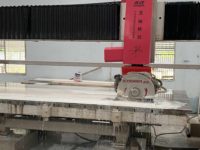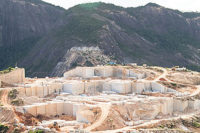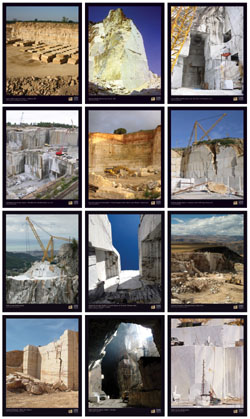When driving down the Pacific Coast Highway (PCH), which hugs the dramatic California coastline from the redwood forests to the sun-drenched beaches of San Diego, one stop worth making is at the Julia Pfeiffer Burns Vista Point in Monterey County near Big Sur. Looking down, you will see a life-size, biologically correct, stone mosaic of the iconic California condor at your feet. A few steps away, there is another life-size replica of a 50-foot gray whale with her baby, also rendered in subtle shades of natural granite, inlaid into the pavement. As you keep driving down the PCH between Santa Cruz and Santa Barbara, you will be treated to seven different vista points, each with multiple interpretive stone displays to inform and inspire you about the wildlife, natural landmarks and history of the local area. How these beautiful interpretive displays of art and nature came about is a story of vision and teamwork that involved the California DOT (Caltrans), a California construction company called RSB Group, field biologists and a small but internationally renowned waterjet company based in Iowa called Creative Edge.
Durable and accurate
Creative Edge Master Shop became involved when RSB Group contracted them to create the design, artwork and installation for the interpretive stone mosaics of four different wild animals — a California condor, a gray whale, a sea otter and a California grizzly — in three different vista points along and near the PCH.
Founded in 1988, Creative Edge has a great deal of experience in waterjet fabrication. “They asked us to render each animal in life-size dimensions,” said Ron Blair, a project manager at Creative Edge who was assigned the PCH project. “That meant the span of the condor wings was 6 feet, the length of the gray whale 50 feet and the width of the grizzly bear 60 inches.”
From Blair’s perspective, granite in all its natural hues was an excellent choice for these massive outdoor mosaics. “In choosing the material for a durable and permanent rendering of these life-size animals, granite is unbeatable,” said Blair. “Waterjet technology, which can cut through brittle granite and stone with the precision of a laser, allowed us to create a beautiful life-size interpretation of each animal in stone.”
Blair points out that these are not sculptures, but intricate mosaics. “Waterjet cutting allows interpretive illustrations to be rendered in stone with biological accuracy,” he said. “And it’s not only cost-effective, it’s virtually permanent and maintenance free.”
Painting in stone
Blair explained this style of interpretation is unique, and likens it to “painting in stone.”
To create the artwork for the mosaics he engaged graphic artist Alice Taylor, who trained in industrial design at the University of Cincinnati and in computer graphics at Rhode Island School of Design.
Besides the condor and the whale at the Julia Pfeiffer Burns vista point at Big Sur, two other locations also included interpretive mosaics by Creative Edge: a life-like sea otter rolling in layers of seaweed at the Arroyo Hondo Vista Point and the California grizzly bear at the Rancho Cielo Vista Point just off the PCH on Route 154, both in Santa Barbara County.
Taylor’s artwork was closely directed by Caltrans’ landscape artist Corby Kilmer. “I started out studying nature photos and biological drawings of the four animals,” she said. “I thought a lot about what position the animal would be in, and the various viewers’ perspectives and how the animal would look from different angles.”
As the artist, one thing was made clear to her: Kilmer wanted the animals to look realistic — both in design and color choice. “They wanted nothing Disney,” said Taylor. “Nothing cartoon. They wanted the viewer to get a feeling for what a real animal looked like in its natural habitat.”
Following that directive was not without its challenges. “Biologists checked the anatomical accuracy of the drawings,” said Taylor. “There were at least eight rounds of revisions with each animal. So even though the art was an interpretation of nature, it was also seriously accurate. For instance, in the case of the condor, at first I had the wings angled upward and I had to add a hump into the wings and make them more horizontal. Small nuances in the shapes and lines were highly scrutinized. You get really deep into this sometimes. It was fun because I’d never worked with biologists on artwork before.”
Besides the outline of each animal’s body, and the surrounding habitat, Taylor had to create the shapes to delineate different shades of color, much like a paint-by-number drawing. She then filled the intricate shapes with colors that would eventually be cut out of stone. The result is a stunning interpretive display that connects viewers to wildlife and natural landscapes in an intimate and inspiring way.
“It’s wonderful that the state of California is doing work like this,” said Taylor. “And it’s refreshing to be part of a project that combines art, culture and nature.”
|
Interactive stone wildlife displays Pacific Coast Highway California General Contractor: RSB Group Waterjet Fabricator: Creative Edge Master Shop, Fairfield, IA Graphic Artist: Alice Taylor
|
From vector art to installation
After the artwork was approved and submitted, Creative Edge worked closely with the Caltrans team to match the colors on the drawings with the colors of the actual granite tiles.
“The granite colors that Creative Edge and Caltrans ended up choosing are absolutely gorgeous,” said Amy Norris, the resident engineer for Caltrans District 5 who supervised the project. “I didn’t even know that granite came in those colors.” Once the granite was chosen, Creative Edge created the key map of each mosaic, which specified the color of granite for each shape on the vector drawings.
For Alice Taylor, this was her first foray into creating art out of stone. “The team at Creative Edge took the vector files of each animal drawing, and from there translated them into CAD programs, the computer language the waterjet machine uses to actually cut the stones,” she said.
Installation is also an art, Taylor notes. “These stone mosaics have to be installed in a way that allows the grout to shrink a little due to weather changes, which means the stones themselves will shift. All that has to be calculated into the installation plan by trained installers.”
Since the concrete base and frame for the mosaic inlays had to be poured first, Creative Edge used its proprietary technique called Trans Formz® to make sure the stone pieces fit into the concrete frame that had already been poured onsite.
The Trans Formz method involved creating the design on panels of corrugated plastic that snap together like puzzle pieces. This enabled the installers to lay down the design in plastic to make sure that it matched the concrete.
“By trying it out in plastic first, the installers could see where they needed a couple of extra inches, or where an arc of the animal shape didn’t quite match the arc of the concrete,” said Blair. “Since our factory is in the Midwest and the installation was in the West, it was important to use this method to first adjust the design in plastic — and once that was done, we made it in stone.”
The return of the condor
In addition to the stone mosaics fabricated by Creative Edge, the seven interpretive sites along the PCH contain 40 display panels with different interpretive elements, such as electronic panels, vintage photographs, a solar audio system and display boulders (interpretive information panels embedded in massive boulders that were locally sourced).
Each rest stop focuses on the unique history, flora and fauna of the surrounding area.
The intent is to make people feel awed by the stories that these displays tell, and how they inform visitors of the California wildlife and history. While gazing at the 6-foot granite condor mosaic at the Julia Pfeiffer vista point, for instance, an interpretive display informs you that in 1982, only 22 California condors were left in the world. A coalition of government agencies, zoos and conservation groups such as the Ventana Wildlife Society joined forces to save the majestic bird. Today, thanks to their efforts, the condor population has grown to 430.
“This interpretive display of the condor is a tribute to this majestic bird and a tribute to the people who helped save it,” said Norris. “It helps the traveler appreciate their surroundings and see their journey in a new way. And it’s going to last for a long, long time.”














